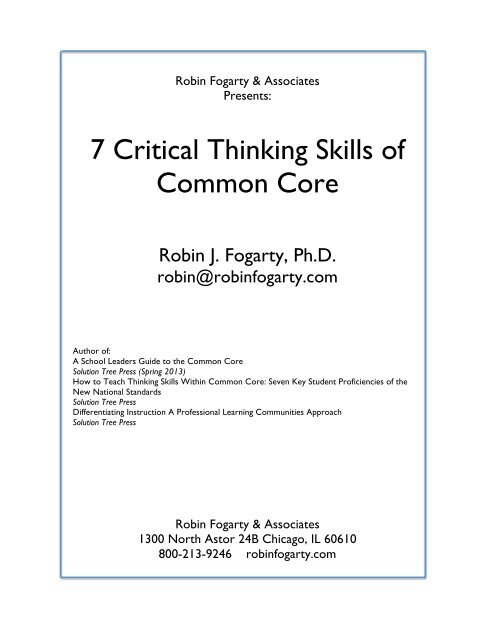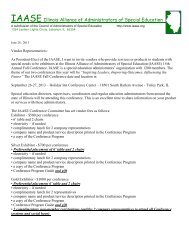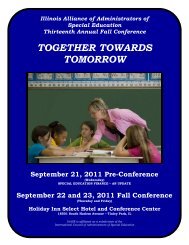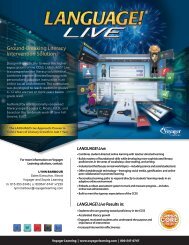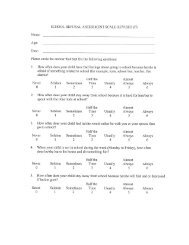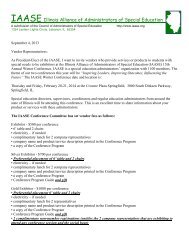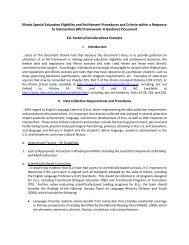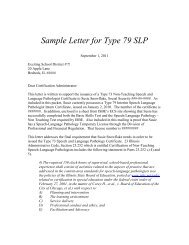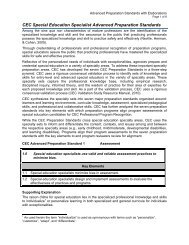Session 30 7 Critical Thinking Skills of Common Core - IAASE
Session 30 7 Critical Thinking Skills of Common Core - IAASE
Session 30 7 Critical Thinking Skills of Common Core - IAASE
- No tags were found...
Create successful ePaper yourself
Turn your PDF publications into a flip-book with our unique Google optimized e-Paper software.
Robin Fogarty & AssociatesPresents:7 <strong>Critical</strong> <strong>Thinking</strong> <strong>Skills</strong> <strong>of</strong><strong>Common</strong> <strong>Core</strong>Robin J. Fogarty, Ph.D.robin@robinfogarty.comAuthor <strong>of</strong>:A School Leaders Guide to the <strong>Common</strong> <strong>Core</strong>Solution Tree Press (Spring 2013)How to Teach <strong>Thinking</strong> <strong>Skills</strong> Within <strong>Common</strong> <strong>Core</strong>: Seven Key Student Pr<strong>of</strong>iciencies <strong>of</strong> theNew National StandardsSolution Tree PressDifferentiating Instruction A Pr<strong>of</strong>essional Learning Communities ApproachSolution Tree PressRobin Fogarty & Associates1<strong>30</strong>0 North Astor 24B Chicago, IL 60610800-213-9246 robinfogarty.com
How to Teach <strong>Thinking</strong> <strong>Skills</strong> Within the <strong>Common</strong> <strong>Core</strong>:Seven Key Student Pr<strong>of</strong>iciencies <strong>of</strong> the New National Standards – Bellanca, Fogarty and Pete - Solution Tree PressHow to Teach <strong>Thinking</strong> <strong>Skills</strong> Within in the <strong>Common</strong> <strong>Core</strong>:Seven Key Student Pr<strong>of</strong>iciencies <strong>of</strong> the New National StandardsBellanca, Fogarty and Pete Solution Tree Press -Unpack the <strong>Common</strong> <strong>Core</strong> State Standards (CCSS) in a balanced way, using richcontent and rigorous thinking processes. The CCSS thread the skills <strong>of</strong> literacy andreading, writing, speaking and listening through narrative and informative text.The key to implementing the CCSS with relevancy, is to address them, with explicitteaching <strong>of</strong> the higher order thinking skills that are embedded in rich subject mattercontent. (ELA, Science, Math, Social Studies, History, Technology).The focus is on the high frequency “thinking skills that students need to master. Theseskills teach kids how to process, analyze, evaluate, produce and present with richcontent and relevant thinking. Here is the Syllabus <strong>of</strong> Seven <strong>Thinking</strong> Skill Sets and 21Explicit <strong>Thinking</strong> <strong>Skills</strong> that thread across all content areas for student pr<strong>of</strong>iciency.Seven Key Student Pr<strong>of</strong>iciencies <strong>of</strong> the New National Standards:Pr<strong>of</strong>iciency #1 - <strong>Critical</strong> <strong>Thinking</strong> - Analyze, Evaluate, Problem SolvePr<strong>of</strong>iciency #2 - Creative <strong>Thinking</strong> - Generate, Associate, HypothesizePr<strong>of</strong>iciency #3 - Complex <strong>Thinking</strong> - Clarify, Interpret, DeterminePr<strong>of</strong>iciency #4 - Comprehensive <strong>Thinking</strong> - Understand, Infer, ComparePr<strong>of</strong>iciency #5 - Collaborative <strong>Thinking</strong> - Explain, Develop, DecidePr<strong>of</strong>iciency #6 - Communicative <strong>Thinking</strong> - Reason, Connect, RepresentPr<strong>of</strong>iciency #7 - Cognitive Transfer <strong>of</strong> <strong>Thinking</strong> - Synthesize, Generalize, ApplyMapping the <strong>Thinking</strong> <strong>Skills</strong>Based on the formative/summativedata for your grade level, departmentor core team. Rate the top fourthinking skills that you think yourstudents can benefit from the most.What thinking skill would you startwith first, etc.?1st Quarter2nd Quarter3rd Quarter4th Quarter___________________________________________Targeted <strong>Thinking</strong> <strong>Skills</strong>__ Analyze__ Evaluate__ Problem Solve__ Generate__ Associate__ Hypothesize__ Clarify__ Interpret__ Determine__ Understand__ Infer__ Compare__ Explain__ Develop__ Decide__ Reason__ Connect__ Represent__ Synthesize__ Generalize__ ApplyRobin Fogarty & Associates 800-213-9246 robinfogarty.com 1
How to Teach <strong>Thinking</strong> <strong>Skills</strong> Within the <strong>Common</strong> <strong>Core</strong>: A Syllabus <strong>of</strong> Seven Student Pr<strong>of</strong>iciencies –Bellanca, Fogarty and Pete - Solution Tree Press 2012K - 5 6 -12ELA MATH ELA MATH33 Represent 47 Analyze73 Solve28 Understand 40 Determine 50 Understand22 Solve36 Develop41 Interpret19 Recognize 27 Research33 Relationships18 Interpret 22 Clarify32 Find18 Find21 Write31 Graph17 Explain 20 Relationships <strong>30</strong> Represent16 Compare 19 Demonstrate 28 Apply14 Describe 18 Understanding 27 Describe1314 Create2613 Write 12 Read26 Explain13 Identify 11 Evaluate22 Prove10 Understanding 9 Reflection 20 Write10 Divide 9 Read/Comprehend 20 Com/Contrast9 Determine 9 Introduce 17 Recognize8 Graph 9 Produce17 Evaluate8 Apply7 Organize17 Determine8 Sequence 5 Point <strong>of</strong> View 15 Identify8 Read5 Apply14 Compute7 Answer 5 Compare/Contrast 12 Develop6 Create 4 Explain11 Produce6 Justify4 Inferences for text 10 Inferences6 Analyze 3 Sequence9 Analyze5 Develop 2 Identify8 Sequence4 Compute 2 Solve8 Divide4 Relationships 2 Projects8 Calculate4 Define 1 Answer8 Decide4 Evaluate 1 Sequences 7 Define4 Produce 1 Accurately 7 Answer3 Calculate 1 Interpret6 Create3 Sequences 1 Collaborate 3 Verify3 OrganizeReflect3 Sequences3Describe2 Justify3Read3Understanding2Reflection1UnderstandingReadWriteDemonstrateClarifyDevelopProduceRelationshipsDescribeCompare/ContrastExplainAnswerIntroduceSequenceProduceDetermineAccuratelyRead/ComprehendPoint <strong>of</strong> ViewApplyResearch/ProjectsCreateDecodeReflectionRetellRecallSequencesInferencesIdentifyCollaborateOrganizeAsk/AnswerShort researchInterpretKnow and UseAnalyzeSolve66544745433938342423211917171313111098877777654332211*This list is a comprehensive representation <strong>of</strong> ELA and MATH CCSS, but it is not acomplete representation <strong>of</strong> complex thinking references.Robin Fogarty & Associates 800-213-9246 robinfogarty.com 1
How to Teach <strong>Thinking</strong> <strong>Skills</strong> Within the <strong>Common</strong> <strong>Core</strong>: A Syllabus <strong>of</strong> Seven Student Pr<strong>of</strong>iciencies –Bellanca, Fogarty and Pete - Solution Tree Press 2012Three - Phase Model: Explicit TeachingPhase I – TALK THROUGH (I Do) - Explicit Teaching <strong>of</strong> a <strong>Thinking</strong> Skill1) Motivating Mind Set-Focus; hook2) Description-Explanation, not definition3) Menu <strong>of</strong> Operations/Acronym4) Instructional Strategy - Process (thinking skill) as the Content5) Assessment-Check for Understanding6) Metacognitive Reflection/Self-assessment; commentaryPhase II - WALK THROUGH (We Do) – Apply to Classroom ContentLessonTeacher Guided Content LessonMotivational Mind Set:Instructional Activity with Standard:Closure with Take Away:Phase III – DRIVE THROUGH (You Do) – Apply to CCSS PerformanceStudent Directed CCSS Performance TaskMotivational Mind Set:Instructional Activity with Exemplar:Closure with Take Away:Robin Fogarty & Associates 800-213-9246 robinfogarty.com 1
Explicit Teaching <strong>of</strong> <strong>Thinking</strong> SkillTalkThroughGrade:Topic:Subject:Standard:Objective:Big Idea:ESSENTIAL QUESTION:MotivationalMind Set:Through Emotionsget Their AttentionSkill Description:WhatStandard RequiresMenu <strong>of</strong> Operations:“How-to” Stepsfor StudentsInstructionalStrategy:“Process asContent”Assessment:Judgement <strong>of</strong>Product or PerformanceReflection:Student Commenton ProcessHow to Teaching <strong>Thinking</strong> <strong>Skills</strong> Within the <strong>Common</strong> <strong>Core</strong>: A Syllabus <strong>of</strong> Seven Student Pr<strong>of</strong>iciencies - Solution Tree Press
Robin Fogarty & AssociatesTeachers Make the Difference800-213-9246 robinfogarty.com
College and Career Ready! Self-Directed! Self-Reliant! Independent ThinkerBook: How To Teach <strong>Thinking</strong> in the <strong>Common</strong> <strong>Core</strong>: & Student Pr<strong>of</strong>iciencies <strong>of</strong> the New National StandardsCollege and Career ReadySpecifically, College & Career Ready means, in the words <strong>of</strong> the CCSS, thatstudents demonstrate independence.Students can, without significant scaffolding, comprehend and evaluate complex textsacross a range <strong>of</strong> types and disciplines, and they can construct effective arguments andconvey intricate or multifaceted information. Likewise, students are able independentlyto discern a speaker’s key points, request clarification, and ask relevant questions. Theybuild on others’ ideas, articulate their own ideas, and confirm they have beenunderstood. Without prompting, they demonstrate command <strong>of</strong> standard English andacquire and use a wide-ranging vocabulary. More broadly, they become self-directedlearners, effectively seeking out and using resources to assist them, including teachers,peers, and print and digital reference materials.What Does It Look Like in the Workplace?To succeed in the 21 st Century, in college and in careers, tobe self-reliant, self-directed and independent, students needto be able to do the kind <strong>of</strong> macro-skills noted explicitly andimplicitly in the new national standards. Describe Specifics!☐ Solve problems☐ Manage oneself☐ Adapt to change☐ Analyze/conceptualize☐ Reflect on /improve performance☐ Communicate☐ Work in teams☐ Create / innovate / critique☐ Engage in learning throughout lifeNotes:Solution Tree Press solution-tree.com 800.733.7790


